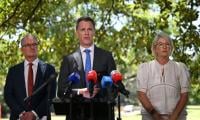The Stand-by Arrangement (SBA) with the International Monetary Fund (IMF) has pulled the country back from the brink of default. The SBA gives Pakistan some breathing space for the needed policy adjustments to be undertaken in an orderly environment. This will help restore macro stability in the short term.
Without IMF support, the adjustments would be more acute and painful. The SBA enables Pakistan to catalyze additional financing from friendly countries, commercial banks, and official lenders. This shields the economy for the time being from greater disruption.
Corrective policy measures under the SBA aim to control budget and external deficits, allow proper functioning of the exchange rate market, rebuild reserves, and proceed mildly on structural reform efforts. The documents agreed with the IMF for the SBA include the Memorandum of Economic and Financial Policies (MEFP), and the Technical Memorandum of Understanding. They present a chilling account of an economy in distress, and are an indictment of the way we have managed our affairs.
The documents describe an economy with multi-faceted challenges, overshadowed by elevated risks. In the given scheme of things, follow-through of the program agreement is the only ray of hope for Pakistan to manage these risks. This will not be a cake walk.
Quantitatively, the IMF assessment highlights that economic headwinds are expected to keep growth muted at 2.5 per cent, unemployment to increase to 8.0 per cent, and inflation to stay elevated at 25.9 per cent in FY24 after a tumultuous inflationary spiral of 29.2 per cent in FY23.
The country did not arrive at this juncture overnight. The current SBA is the 23rd facility with the IMF to be availed by Pakistan since 1947. Pakistan could not complete 22 of these engagements. It bowed out from the programmes after some tranches, but after inflicting hardships on the citizens through austerity and demand compression actions. Pakistan cannot afford to let this happen anymore, given the precarious economic conditions.
The IMF-supported SBA can only have a real chance of success once Pakistan authorities take strong ownership of the agreed course of action and have a professional team steering implementation of program modalities for successful IMF reviews. The SBA is subject to prior actions, quarterly performance criteria (QPC), continuous performance criteria (CPC), indicative targets (IT), and structural benchmarks (SBs) – all reviewed quarterly as set out in the MEFP. Completing the first review scheduled in November 2023 for the release of $720 million requires Pakistan’s authorities to comply with the targets set under all these heads by end-September 2023.
QPCs are specific, measurable conditions of the Pakistan economy. They relate to macroeconomic variables under the handling of Pakistan’s fiscal and monetary authorities. QPCs include limits of monetary and credit aggregates, international reserves, fiscal balances, external borrowing, and cash transfers for the vulnerable. Hopefully, we can muster the expertise and monitoring to manage compliance.
The CPC mandates zero borrowing by the government from the SBP and zero ceiling on the accumulation of external public payment arrears. ITs are more flexible numerical trackers and are set for Pakistan as quantitative indicators to monitor progress on tax revenues, tax refunds, and arrears in the power sector.
Structural benchmarks (SBs) are reform measures that may not be quantifiable but are used as markers to assess program implementation. An innovative and continuous SB pertains to managing the exchange rate regime. It stipulates that the average premium between the interbank and open market rate be contained to 1.25 per cent during any consecutive five business days. Additionally, Pakistan must not grant any tax amnesties and avoid issuing new preferential tax treatments or exemptions throughout the program.
Authorities must show progress on the agreed SBs on SOEs including a performance report by the end of December 2023, operationalization of the approved SOE law, and amendment of acts of four SOEs by end-November 2023. Inflationary adjustment of cash transfers has to be ensured by end-January 2024. The MEFP highlights higher risks of climate change. The cabinet is to adopt a climate-public investment management assessment action plan by end-December 2023. Lastly, on SBs, Pakistan has to ensure the compilation of quarterly national accounts starting with FY24Q1 by November 2023.
Other areas of reform include fully operationalizing the treasury single account, phasing out the refinancing schemes through the SBP, and undertaking cost-reducing reforms in the energy sector. Pakistan must also ensure cost recovery from the energy sector and reduction of subsidies. Hopefully, proper work in each area is already underway and being monitored by authorities.
Estimates of both the external and fiscal accounts present acute challenges with a need for corrective actions. Pakistan’s gross financing needs (GFN) are estimated at $28.4 billion in FY24 and cumulatively $121 billion in the following four fiscal years to FY28. This GFN is with a modest current account deficit (CAD) averaging $7 billion over the next five years. CAD can potentially rise as the economy starts to gather steam pushing GFN higher. In FY24 the risks to CAD include the 22 percent increase envisaged in remittances and over 20 percent in exports.
IMF acknowledges that the SBA is fully financed (external needs are being met) but cautions of “exceptionally high risks”. Concern about financing needs and debt sustainability requires Pakistan to stay on top of the game. Debt reprofiling efforts can shield the economy from an acute crisis otherwise deeper restructuring of sovereign debt may become unavoidable for Pakistan. The issue of Pakistan’s public external and domestic debt needs some serious thinking. A competent set of people must be deputed to focus on reprofiling both sovereign and Independent Power Projects’ debt. The clock is ticking on this one.
The equally uneasy part is the prescribed fiscal path. Pakistan authorities have agreed with the IMF to manage a primary fiscal surplus of 0.4 per cent from FY24 to FY28. This is an uphill task. It envisages a whopping tax increase of 33 per cent and 85 per cent in non-tax revenue and a provincial cash surplus of Rs900 billion in FY24. With an economy in stagflation, these figures raise serious red flags.
The primary account has been in deficit every single year for the last decade. The deficit has averaged around 2.0 per cent of GDP for the last five years and 1.5 per cent of GDP over the last 10 years. Authorities will need to carry out formidable reform and extensive monitoring of tax, expenditure, subsidy, wage, and pensions for turning a perpetual primary deficit into a surplus. This is quite improbable, especially in a short period of time. The state has struggled in the past to do a worthwhile reform in any of these areas.
The challenges and risks of keeping the SBA on track are indeed daunting and unparalleled. They require extraordinary measures, some of which Pakistan has never been able to see through before. However, getting to the finish line on the SBA is survival. Materially altering the odds for completion of the SBA in our favour requires marshaling professional capacity to engineer consistent and clear implementation of the majority of policy actions agreed upon with the IMF.
The writer is former adviser, Ministry of Finance. He tweets @KhaqanNajeeb and can be reached at:
khaqanhnajeeb@gmail.com















